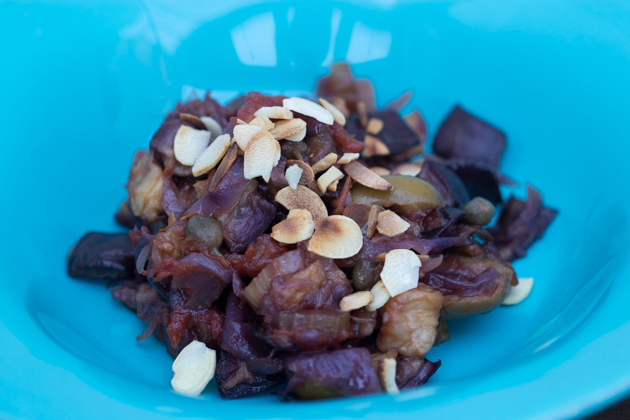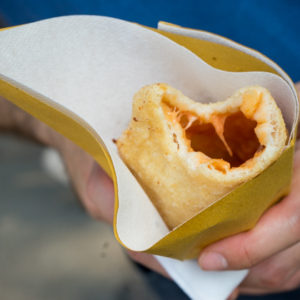
In some ways, the diversity of Sicilian cuisine and its history is exemplified through caponata. This simple dish of sweet and sour vegetables (typically primarily aubergine) changes depending where you are on the island. It is a story of a mixed marriage. Sweet and sour was brought to Sicily by the Arabs who invaded the island (along with citrus, rice, sugar and spices) in the 9th century. The most obvious resemblance to caponata is ratatouille, a French dish, likely introduced by the Bourbons who ruled Sicily in the 18th century.
Travel through Sicily eating caponata and you will find versions with zucchini, peppers, potatoes, olives, artichokes, apples, anchovies, sardines, basil, pine nuts or almonds, tomato paste or fresh tomatoes, honey or sugar, sultanas and even chocolate! This also means, that if you find yourself lacking an ingredient or in over abundance of another, feel free to substitute.
The recipe I was taught is from Menfi and has a clean, light flavour that is refined and well balanced. It has a slightly tangy tomato flavour which finishes slightly sweet. The creaminess of the aubergine (eggplant) is accented with a bit of crunch from the celery and almonds. Make it once and it will be a staple in your refrigerator.
Caponata should be made in huge batches as it can be preserved in jars sealed with olive oil in the refrigerator; a jar ready to crack open at the sound of a friendly knock on the door. Its flavour actually improves with time and if you can resist, wait a day before eating. Caponata can be served as a starter on its own or with burrata cheese; a side to grilled swordfish or as a snack on grilled or toasted bread.
This recipe was taught to me by chef Angelo at the Planeta estate in Menfi. It was his grandmother’s recipe. It owes its lightness to the fact that the onions are caramelised in water rather than oil. The caramelised onions add most of the sweetness to the dish rather than the too-obviously-sweet sugar. Also the aubergine is fried in very hot oil so that it absorbs minimal oil (which is evident when it is drained on kitchen paper) so the dish is not in the least heavy or greasy. For an illustrated step-by-step guide, see here.
Caponata (sweet and sour aubergine (eggplant))
500 grams aubergine, rinse, cut off the stem and diced into 1.5cm cubes (skin on)
500 grams onion, peel the skin, trim the ends, and finely slice
250 mls tomatoes
100 grams celery from the heart (the yellow centre pieces), trim the ends, and finely slice
25 grams capers, salted
50 grams green olives, pit and halve
25 mls red wine vinegar
25 grams sugar
15 mls extra virgin olive oil
sunflower oil for frying
25 grams flaked almonds, toasted
Sea salt
Black pepper, freshly ground
Instructions:
- Soak the aubergine for at least half an hour in cold water to cover with 60 grams of salt mixed in. This removes any bitterness from the aubergine and prevents the aubergine from absorbing too much oil.
- Add 100 mls of hot water to a large saucepan and add the onions over low heat. Cook for 1 hour, adding hot water as needed until the onion begins to lose its form.
- Meanwhile fill a small saucepan with water. Heat the water over medium high heat until it boils. Fill a medium sized bowl with cold water and add ice. Score the tomatoes, put into the boiling water and wait until the skin starts to loosen (it should be less than a minute). Using a slotted spoon, put the tomatoes in the ice water and remove the skin and seeds. Add the celery to the hot water and boil for 2 minutes and remove with a slotted spoon into the ice water. Next add the capers to the water and boil for 2 minutes and remove with a slotted spoon into the ice water.
- Rinse the olives.
- When the aubergine is done soaking, drain the water. Use a dish cloth to squeeze any excess moisture out of the aubergine.
- Place a paper towel on a plate and set aside. Pour the sunflower oil into a saucepan to a depth of 10 cm and heat over medium heat. Use a candy thermometer to measure the temperature. When it reaches 190C, add some of the aubergine so it forms a layer in the oil but is not overcrowding the pan and reducing the temperature of the oil too much. Fry the aubergine for 5 minutes until golden brown. Use a slotted spoon to remove the aubergine and place it on the paper towel lined plate. Repeat until all the aubergine is cooked.
- When the onion is finished cooking, add the tomato, celery, olives and capers to the onions and cook for 10 minutes. Add the vinegar and sugar and cook for another 2 minutes. Add salt to taste.
- Place the aubergine in a container and pour the onion tomato mixture over the top. Drizzle the top with olive oil.
- Let the mixture cool and keep refrigerated for at least 2 hours to overnight. Garnish with the almonds when ready to serve. The caponata can be kept in the refrigerator for up to a week or jarred and sealed with olive oil and kept in the refrigerator for up to 6 months.








Leave a Reply